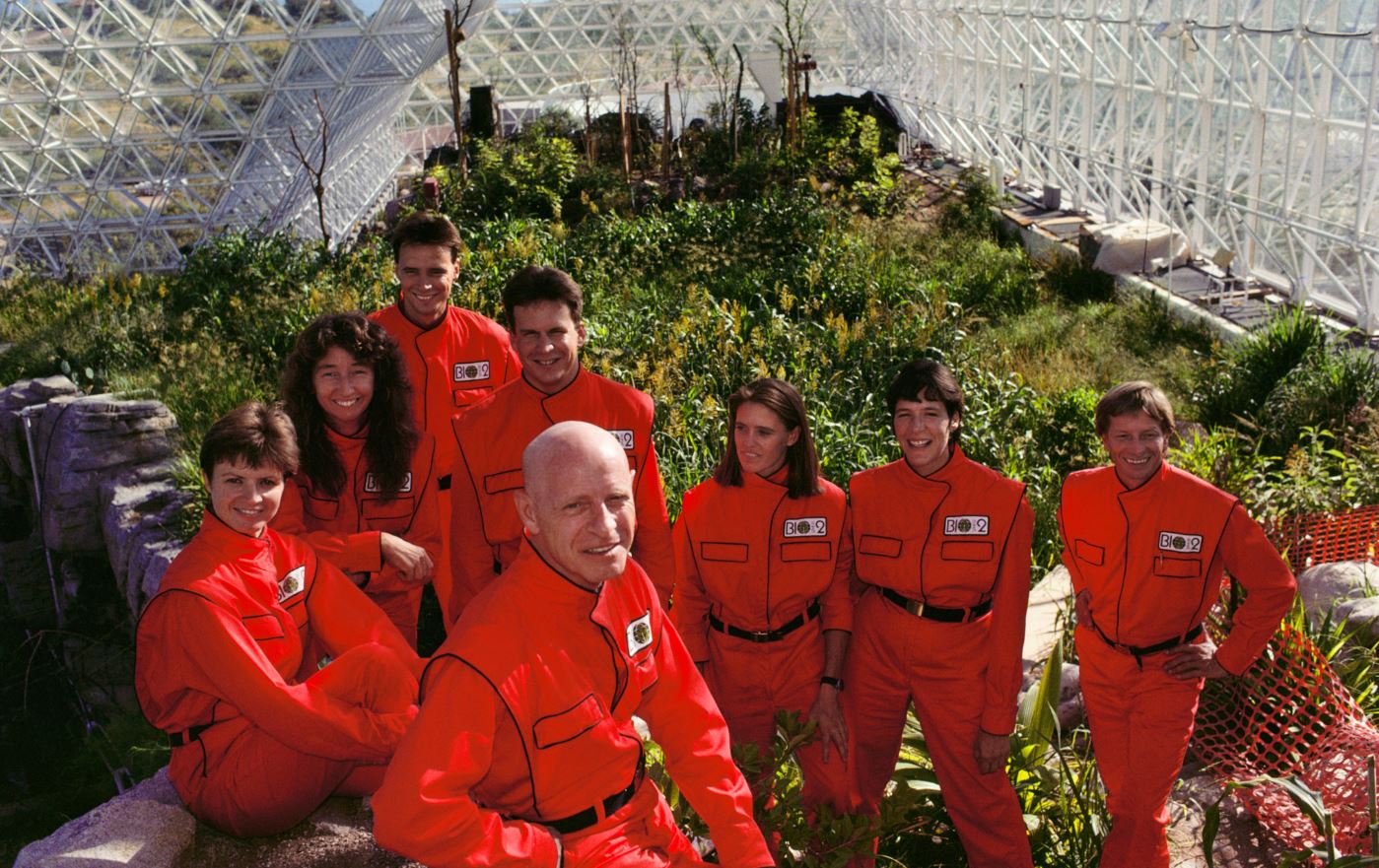Matching jumpsuits. Soaring white geodesic Fuller domes. Desert setting. Beaming smiles from people who appear not unfamiliar with things like EST seminars and primal scream therapy. Grainy film footage. The sense of embarking on a mission that is technically Earth-bound but holds within it the potential for cosmic transcendence. In other words, the story that lies at the core of Matt Wolf’s documentary “Spaceship Earth” bears more than a passing resemblance to the Dharma Initiative in “Lost.”
The movie tells the story of the ill-fated Biosphere 2 project. A much-hyped convergence of 1960s idealism, 1990s “Inside Edition” tabloid culture, and nascent Silicon Valley futurism. The project is remembered by most people now as a failed promise. It was planned as a closed ecosystem in which eight “bionauts” would live for two years in complete isolation to show how future space colonies might operate and also illustrate the fragility of a climate change-ravaged Earth (or as the project called it, “Biosphere 1”). Billed as an unprecedented experiment in sustainability, it was quickly depicted as a bust, with nyah-nyah-told-ya-so stories about ways the project seemed to be breaking its own rules (allowing one bionaut to leave for medical attention and return, pumping in oxygen when CO2 levels spiked). Rumors swirled about the group’s weird-seeming countercultural origins, with suggestions that their leader, John Allen, had a cult-like hold over the project.
It’s a story rife with the potential for schadenfreude, like the “Whole Earth Catalog” version of the Fyre Festival. But Wolf takes a different tack, for better and for worse. Most rewardingly, the filmmaker doesn’t follow the common tactic of modern-day streaming nonfiction miniseries to present a gleaming surface before peeling it back and showing the darkness underneath. The movie’s first half is mostly taken up by a richly textured background story of how the group came together, mostly by the people themselves. Starting in 1967, a swirl of seekers coalesced in San Francisco around Allen, a polymath who after being in the Army, working as a union organizer, and getting an MBA, decided to form a commune with some like-minded souls. The miscellany came from all different backgrounds but the members shared a desire to do something new and exciting with their lives. According to the 16mm footage included here, much of that appeared to involve the kind of loopy amateur experimental theater that was more about consciousness-raising and groupthink than artistic expression.
Ditching the Bay Area’s druggie hedonism for New Mexico, they started a commune called Synergia Ranch with a focus on sustainable agriculture. A few years later, they decided to build an ocean-going ship, just because. Incredibly, without any formal training, they did and sailed it around the world. Even with the group relating their memories in beaming terms, given all the markings of a typical cult—Allen’s powerfully demanding personality and eclectic background, plus their nautical fixation and desire to please him, can’t help but call to mind L. Ron Hubbard and Scientology’s Sea Org—it is hard not to be waiting for the next shoe to drop. But somehow that never happens. Even when the movie reveals that many of the group’s projects were funded by Texas oil billionaire Ed Bass, it turns out they still had to pay their way, starting money-earning businesses like an art gallery in London and a hotel in Kathmandu. If this is a cult—and the movie does pose provocative questions about the thin line between a cult leader and visionary—it’s a curiously low-key and rational one.
Once “Spaceship Earth” delves into the Biosphere 2 element of the story, though, its desire to show a different side of the story becomes somewhat more problematic. By limiting the interviews only to members of the group itself, Wolf narrows the scope of his story. There is a narrative here about the pump-and-dump style of gotcha journalism that was especially prevalent when the project launched in 1991. But while one interviewee tries to place the blame for the negative coverage on people like Allen (a cagey interview himself who reveals almost nothing in his few short clips) overpromising, a more investigative director would have delved deeper into real questions about the experiment’s scientific validity.
The movie is also frustratingly quiet when it comes to the details of the experiment itself. These eight people were stuck together in small quarters for two years with limited food and entertainment. Despite this potential powder keg, except for some griping about their “medical officer” (a live-forever California health obsessive with a narrow view of his duties), there is almost no talk about the fraught interpersonal dynamics, positive or negative.
Nevertheless, the bright intellectual vibrancy of its subjects and the addition of a jaw-dropping deus ex machina (it involves Wall Street and an earlier version of a figure who later gained infamy in Trump circles) makes up for some of these deficiencies. In the end, “Spaceship Earth” is a highly watchable document from a curious cultural convergence in which avant-garde “Star Trek” utopianism met the glare of the mainstream. [B]
“Spaceship Earth” is available now in select theaters and VOD. You can see an exclusive clip from the film below:





